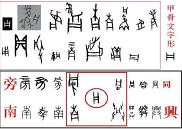Starting from about the fifth century BC, we begin to find examples of writings on bamboo strips. Before writing the characters with a hard brush or a stick on the bamboo surface, the strips were prepared in advance and tied together with strings to form a roll. The new media also means new content: along with historical and administrative writings, the bamboo strips contains the earliest manuscripts of famous Chinese philosophical texts, such as the Laozi, Liji, and Lunyu. | 
|
Beside bamboo, texts were also written on wooden tablets and silk cloth. The written language by this time is the so-called "classical Chinese" which had remained more or less the same as late as the 19th century.
? A major event in the history of Chinese script is the standardization of writing by the First Emperor of Qin who unified China in 221 BC. Before that time, each of the many states in China had their own style and peculiarities which meant that, although mutually comprehensible, the scripts had many deviations. The First Emperor introduced the Qin script as the official writing and from there on all the unified states had to use it in their affairs. The calligraphic style of this period is the "clerical script" or lishu which is easily readable today even to the uninitiated.
Dragon bones were worth only 1800 coins each in December 2008, but a combination of inflation, the release of the Ancient Curses, and higher demand in general has brought dragon bones to their current price of about 5,500 coins each. As of June 11th they have raised to about 5,900 coins, and the price continues to rise. In 2007, the price of dragon bones went as low as 1000 each due to the huge supply from the real world traders. The earliest examples of Chinese writing date to the late Shang period (ca. 1200 BC). These are the so-called Oracle Bone Inscriptions (jiaguwen) which were found at the site of the last Shang capital near present-day Anyang, Henan province. |